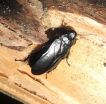Steroid-based treatment may answer needs of pediatric EoE patients
2014-12-19
(Press-News.org) Bethesda, MD (Dec. 19, 2014) -- A new formulation of oral budesonide suspension, a steroid-based treatment, is safe and effective in treating pediatric patients with eosinophilic esophagitis (EoE), according to a new study in Clinical Gastroenterology and Hepatology, the official clinical practice journal of the American Gastroenterological Association. Eosinophilic esophagitis is a chronic immune system disease caused by a buildup of white blood cells in the lining of the esophagus. This build up, which is a reaction to food, allergens or acid reflux, can inflame or injure esophageal tissue.
"EoE patients struggle daily, as the damage to their esophagus makes swallowing and eating a formidable challenge," said Sandeep K. Gupta, MD, lead study author from Indiana University School of Medicine and Riley Hospital for Children, Indianapolis. "There is a dire need for a safe and effective EoE treatment, as currently, there are no FDA-approved treatments for this condition. Oral budesonide suspension demonstrated remarkable efficacy to reduce eosinophilic inflammation in our study, offering hope for EoE patients."
Researchers conducted a prospective, randomized, double-blind, placebo-controlled study to assess the effectiveness and safety of oral budesonide suspension -- a new, proprietary, oral formulation of budesonide -- in children and adolescents (ages 2-18) with EoE. Patients were randomly assigned to groups given placebo, low-dose, medium-dose or high-dose therapy for 12 weeks. At the end of 12 weeks, histologic (improved tissue) response was achieved in more than 50 percent of patients in the medium-dose group and in more than 90 percent of patients in the high-dose group. Only 5.6 percent of patients in the placebo group experienced improved histologic response; there was no significant difference in percentages of responders between the low-dose and placebo groups. Oral budesonide suspension was safe at all doses and there were no serious drug-related adverse events.
While EoE patients experienced significant histologic response in the medium- and high-dose groups, patients in all four groups experienced comparable symptom responses. Further research is needed to assess this treatment's ability to improve symptoms.
Oral budesonide suspension is designed to coat the esophagus with budesonide in order to treat local eosinophilic inflammation. Budesonide -- a glucocorticoid steroid -- is the active pharmaceutical ingredient in several products approved by the U.S. FDA, including products for the treatment of pediatric and adult asthma, allergic rhinitis, chronic obstructive pulmonary disease and Crohn's disease.
INFORMATION:
This study was sponsored by Meritage Pharma, Inc.
1 Gupta, Sandeep K., et al. Efficacy and Safety of Oral Budesonide Suspension in Pediatric Patients With Eosinophilic Esophagitis. Clinical Gastroenterology and Hepatology 2015: 13(1): 66-76.e5
About the AGA Institute
The American Gastroenterological Association is the trusted voice of the GI community. Founded in 1897, the AGA has grown to include more than 16,000 members from around the globe who are involved in all aspects of the science, practice and advancement of gastroenterology. The AGA Institute administers the practice, research and educational programs of the organization. http://www.gastro.org.
About Clinical Gastroenterology and Hepatology
The mission of Clinical Gastroenterology and Hepatology is to provide readers with a broad spectrum of themes in clinical gastroenterology and hepatology. This monthly peer-reviewed journal includes original articles as well as scholarly reviews, with the goal that all articles published will be immediately relevant to the practice of gastroenterology and hepatology. For more information, visit http://www.cghjournal.org.
Like and Clinical Gastroenterology and Hepatology on Facebook.
Join AGA on LinkedIn.
Follow us on Twitter @AmerGastroAssn.
Check out our videos on YouTube.
ELSE PRESS RELEASES FROM THIS DATE:
2014-12-19
The changes can be measured, but their reasons were unknown. For several decades, scientists have carefully observed that the oxygen minimum zones (OMZ) in the tropical oceans are expanding. These zones are a paradise for some specially adapted microorganisms, but for all larger marine organisms such as fish and marine mammals they are uninhabitable. Thus, their expansion has already narrowed down the habitat of some fish species.
Marine scientists from the GEOMAR Helmholtz Centre for Ocean Research Kiel and the Kiel Collaborative Research Centre (Sonderforschungsbereich, ...
2014-12-19
PITTSBURGH--University of Pittsburgh researchers have shared their findings from three studies related to shale gas in a recent special issue of the journal Energy Technology, edited by Götz Veser, the Nickolas A. DeCecco Professor of Chemical and Petroleum Engineering in Pitt's Swanson School of Engineering.
In the special issue focusing on shale gas, Pitt faculty authors look at "smart wells" that use wireless communication, wastewater management, and information gaps between legislators, regulators, industry representatives, researchers, and the public on the ...
2014-12-19
Scientists from the Southwest University, Chongqing, China have found a new species and a new subspecies of cockroach. What makes these creepy crawlies distinctive from the cockroaches most of us know is that they don't infest human houses, on the contrary they prefer to live a hermit life drilling logs, hidden away from human eyes. The study was published in the open access journal ZooKeys.
Out of around 4,600 species worldwide, only 30 are the cockroaches associated with human habitats that gives the bad fame of these creatures. The representatives of the genus Panesthia, ...
2014-12-19
Most parents are not surprised by the irregularity of a newborn infant's sleep patterns, but by six months or so many parents wonder if something is wrong with their baby or their sleeping arrangements if the baby is not sleeping through the night. Healthcare providers, specifically nurse practitioners, can help parents understand what "normal" sleep patterns are for their child, according to researchers.
"Nurse practitioners are at the frontline of healthcare," said Robin Yaure, senior instructor of human development and family studies, Penn State Mont Alto. "They are ...
2014-12-19
Jacksonville, FL (December 19, 2014) - Investigators have found that young children with type 1 diabetes (T1D) have slower brain growth compared to children without diabetes. A new study, published in the December issue of Diabetes, now available ahead of print, suggests that continued exposure to hyperglycemia, or high blood sugars, may be detrimental to the developing brain. The research was supported by the National Institutes of Health (NIH).
"Our results show the potential vulnerability of young developing brains to abnormally elevated glucose levels, even when ...
2014-12-19
(MEMPHIS, Tenn. - DECEMBER 18, 2014) A study led by St. Jude Children's Research Hospital scientists has identified the population of white blood cells that tumors use to enhance growth and suppress the disease-fighting immune system. The results, which appear in the December 18 edition of the scientific journal Immunity, mark a turning point in cancer immunology and provide the foundation for developing more effective immunotherapies.
For years, researchers have known that a diverse group of white blood cells called myeloid-derived suppressor cells (MDSC) are more abundant ...
2014-12-19
In a previous randomized controlled trial, Stanford University researchers developed two curricula for Girl Scouts to use energy more efficiently: one on energy use at home, and the other in transportation and food. Both courses were effective for girls in the short term, and the home energy course was effective for girls in the long term and for parents in the short term.
Subsequently, the Northern California Girl Scouts began disseminating the programs via manuals and reusable materials, but that method of disseminating the programs has not lead to widespread use.
On ...
2014-12-19
[Boston, MA December18, 2014] Parents of children involved in an elementary school-based community intervention to prevent obesity appear to share in its health benefits. A new analysis of Shape Up Somerville: Eat Smart Play Hard™ shows an association between being exposed to the intervention as a parent and a modest decrease in body mass index (BMI) compared to parents in two similar control communities. The study led by researchers at the Friedman School of Nutrition Science and Policy at Tufts University and the Centers for Disease Control and Prevention (CDC) ...
2014-12-19
University of Chicago developmental neuroscientists have found specific brain markers that predict generosity in children. Those neural markers appear to be linked to both social and moral evaluation processes.
There are many sorts of prosocial behaviors. Although young children are natural helpers, their perspective on sharing resources tends to be selfish. Jean Decety, the Irving B. Harris Professor of Psychology and Psychiatry, and Jason Cowell, a postdoctoral scholar in Decety's Child NeuroSuite lab, wanted to find out how young children's brains evaluate whether ...
2014-12-19
Australian scientists have developed a model for oil palm cultivation, aimed at helping growers of the crop maximize the yields of their plantations, while minimizing detrimental environmental impacts.
The model was recently published in the journal Environmental Modeling & Software.
"Oil palm has become a major crop in the tropics, cultivated on more than 39 million acres of land," co-author Dr Paul Nelson of James Cook University (JCU) said.
"Demand for the product continues to grow, and the industry is expected to keep expanding in the foreseeable future.
"At ...
LAST 30 PRESS RELEASES:
[Press-News.org] Steroid-based treatment may answer needs of pediatric EoE patients


